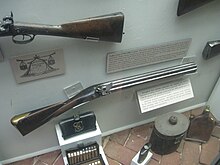Nock rifle
The Nock rifle was a hand-held volley rifle with gunpowder charges designed by the British designer James Wilson in 1779 and manufactured by the London gunsmith Henry Nock . The firearm was named after Henry Nock .

history
In 1779, James Willson, a captain in the Royal Marines , introduced a seven-barrel volley rifle to the Board of Ordnance . Willson's concept wasn't new, comparable weapons existed 300 years earlier, so he didn't patent it. His part was to reissue the concept with the state of the art at the time and to turn it into a usable weapon.
The first attempts took place on July 29, 1779 in the Royal Arsenal . The Bord of Ordnance was positive about the rifle, but not for use on land, but on warships , from Mars . The gunsmith Henry Nock was commissioned to produce two more copies. Since he had received this order and so far has only supplied bayonets and weapon locks for the Bord of Ordnance , it is assumed that he also made the prototype. The barrels of the prototype and the two other rifles were drawn , all other rifles had a smooth barrel. Probably the Bord of Ordnance and the Admiralty had made further attempts at firing and changed the specifications. Nock received an order for another 20 rifles.
Willson wanted to remain involved in further attempts, but he was paid out on May 23, 1780 with £ 400 and was henceforth no longer involved in the rifle; this was therefore known after the manufacturer as the nock rifle . On January 31, 1781, Nock delivered the last rifles of the next order of 547 pieces. Then there was a small order for six pieces in 1784 and over 100 in April 1788.
Nock also sold an unknown, probably small, number to civilians as sporting rifles, from 1789 until his death in 1804. At least some of these had rifled barrels. Similar seven-barreled rifles were also offered by some London gunsmiths after 1804.
The nock rifles bought by the Royal Navy were intended to be used against enemy boarding troops. The shooter of a Nock rifle risked a broken shoulder due to the enormous recoil force of the seven barrels fired at the same time, while the officers also had concerns about using the weapons during the battle, as the sparks from the weapons could set the rigging and sails on fire. A lower powder charge weakened the recoil somewhat, but the weapon was still unpopular and was hardly used.
Based on the volley rifle , Nock built a carbine with a rotating 6-barrel barrel, practically a large bundle revolver .
technology
The Nock rifle consisted of seven hard-soldered rifle barrels , of which the six outer ones at the rear end were each connected to the inner middle barrel by a small hole. The weapon was fired through one of the outer tubes with a common flintlock mechanism and an ignition pan , which in turn ignited the propellant charges through the holes to the other barrels. Thus all seven charges were fired more or less simultaneously. The first models had rifled gun barrels, but were very cumbersome to load. Later models were therefore mostly made with smooth barrels; Although this benefited the loading speed, the accuracy and firing range of the weapons deteriorated. The rifle measured 939.8 millimeters and had 508 millimeter long barrels with a caliber of 0.52 inches (13.2 millimeters). The specimens used by the British Royal Navy were retired by 1804.
Museum reception

A nock rifle can be found in the Charleston Museum in Charleston, South Carolina . The copy of the Royal Collection is on loan to the Royal Armories in Leeds .
Another, technically similar rifle can be found in the National Archaeological Museum in Athens . This exhibit is attributed to the Greek admiral Konstantin Kanaris ; its technical assignment as a nock rifle is unproven due to the percussion lock .
Media reception
Despite the fact that the weapon has hardly been used practically, it is often portrayed in films as an unusual weapon. In the 1960 film Alamo , she is unrealistically portrayed in the hands of James Bowie . There is no historical evidence that Bowie owned this weapon. The British series The Snipers offers a more realistic representation
literature
- Ian V. Hogg: The encyclopedia of weaponry. Greenwich Editions, 1999, ISBN 0-86288-153-6 .
- Peter S. Wainwright: Henry Nock. ( online PDF file )
Web links
Individual evidence
- ↑ a b catalog Peter Finer, 2007, pp. 186–187 [1]
- ^ A b c Peter S. Wainwright: Henry Nock, Innovator , in: The American Society of Arms Collectors, Bulletin Number 88, Fall 2003
- ↑ a b Gerald Prenderghast: Repeating and Multi-Fire Weapons: A History from the Zhuge Crossbow Through the AK-47 , McFarland Verlag, 2018, ISBN 9781476631103 , pp. 49-50 [2]
- ^ Henry Nock Revolving Flintlock Carbine
- ↑ Flintlock seven-barrel rifle 1792
- ^ Matthew Sharpe: Nock's Volley Gun , American Rifleman , Nov. 19, 2012